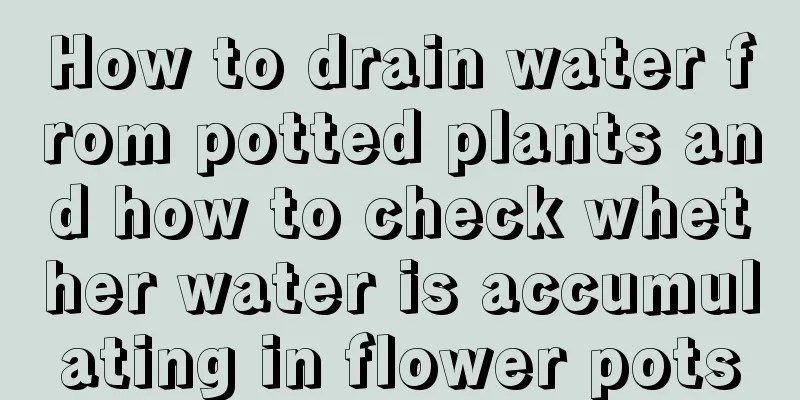How to drain water from potted plants and how to check whether water is accumulating in flower pots

1. How to drain water from potted plants1. There is water accumulation in the bottom tray If it is a smaller potted plant that can be moved, just pour out the water in the bottom tray. If it is a larger potted plant that is difficult to move, you can use a large syringe to drain the water from the tray, or you can replace the bottom tray with a bottom tray that can collect water. 2. Raise the pelvic floor If the gap between the flower pot and the base is too small, the air permeability of the flower pot will be poor. At this time, you can use bottle caps or other flat objects to pad between the flower pot and the base to increase air permeability so that the accumulated water can be drained quickly. 3. Drilling holes in the basin wall If it is a plastic flower pot, the air permeability will be relatively poor. Especially in summer, watering can easily cause water to accumulate in the pot, making the bottom impermeable. At this time, you can drill holes in the basin wall to help the accumulated water drain quickly. It should be noted that the size of the hole should be appropriate and not too large, so as to avoid exposing the soil in the pot after watering. 4. Add a breathable layer Adding dry needles, broken bricks and tiles, expanded clay, willow branches, charcoal and other things to the bottom of the pot or the soil to add a breathable layer to the potted plants can effectively prevent water accumulation in the pot and also help drain the accumulated water. 5. Loosen the soil When the soil in the pot is waterlogged, you can loosen the soil. Insert the loosening tool around the flowerpot and gently shake the soil to loosen it, increase the air permeability of the soil, and drain the accumulated water in the pot. 2. How to judge whether the flower pot is waterloggedWater the plant when the weather is nice and sunny, and then observe the soil in the pot the next day. If the soil in the pot becomes dry and appears slightly white, there is no water accumulation in the pot; if the soil in the pot remains moist, there may be water accumulation in the pot; if the soil in the pot remains moist after 3-5 days, it means that there is serious water accumulation in the soil and the roots may have rot problems. |
<<: How can gourds bear more fruits? How to cultivate gourds so that they can bear more fruits
Recommend
Why can't Clivia be given as a gift?
1. Reasons why you can’t send it at will (1) Acco...
What is cinnamon and what are its benefits?
1. What is Cinnamon is its scientific name, also ...
What to do if the roots of tiger plant rot
Causes of root rot Overwatering The root system o...
How to water chrysanthemums
1. Water selection Do not use water lightly. Use ...
When is the best time to transplant mugwort?
The transplanting of mugwort is generally carried...
How to grow Epiphyllum quickly
1. Good soil Soil is very important, and the main...
What flowers are suitable for growing in Changzhi? What are the city flowers and trees?
1. Climate characteristics of Changzhi Changzhi i...
How and when to plant Chinese cabbage
Suitable planting time for Chinese cabbage Cabbag...
How to grow rosemary more vigorously
Rosemary Growing Conditions Rosemary prefers a wa...
Cultivation methods and precautions of Jade Cactus (How to cultivate Jade Cactus)
The Jade Mangold is a plant of the genus Mammilla...
When and how to plant winged beans
Planting time of winged beans Winged beans are no...
The efficacy of mosquito grass
1. Efficacy The mosquito grass with galls can be ...
The impact of cyclamen on the home environment
Purify the air Cyclamen has a strong ability to a...
Economic crops suitable for dryland cultivation Crops grown in arid areas
The barren land is dry land, so you can grow some...
How to care for Phalaenopsis after it blooms
1. Proper pruning After the flowers fade, proper ...









